
Editorial
by BROGAN BUNT and LUCAS IHLEIN
- View Brogan Bunt's Biography
Brogan Bunt is an artist and Associate Dean (Education) within the Faculty of Law, Humanities and the Arts, University of Wollongong.
- View Lucas Ihlein's Biography
Lucas Ihlein is an artist and ARC DECRA Research Fellow at University of Wollongong.
Fieldwork
Brogan Bunt
I am ambivalent about fields and fieldwork.
Perhaps this is part of operating within a field. A field is at once open and delimited. We speak of going out into the field. There is a sense of pleasure and freedom – at least initially. Then we must work. Although work does not actually follow, but is rather an essential feature of establishing a field – the labour of tilling soil, building a fence or pursuing a line of research. A related and subsequent labour involves maintaining a sense of openness within a necessarily delimited space. Art, for instance, projects within its field an endless relation to other fields, an endless sense of non-aesthetic opening.
But this is scarcely an adequate explanation for the contemporary concern with fieldwork, which emerges not only as an impulse within art but also as a consequence of a broader cultural reconfiguration, in which art, activism, social enquiry and research enter into new relations. From a cynical perspective, the contemporary currency of the notion of fieldwork can appear as a convenient adaptation to new systems of cultural validation and patronage. Fieldwork can appear as a methodological alibi for dimensions of practice that can no longer be spoken. But it also represents a deliberate effort to discover a new social relevance for art and to rigorously pursue expanded methodological possibilities.
The Tate Modern has recently opened a new gallery, Tate Exchange. Taking up a whole floor of the Switch Building, it is a largely empty space, with a few tables and chairs, sofas and bulletin boards. It is a space for participatory social practice that renders explicit an emerging artistic paradigm. It focuses attention on a methodological approach in which aspects of a field, studio, informal learning space, research laboratory and gallery coincide. The artists employ all manner of different approaches, but share a resistance to the conventional studio or gallery. Their commonality is defined ex nihilo in terms of an absence of anything that is primarily focused on display - that is not fundamentally oriented towards ephemeral dialogue and interaction.
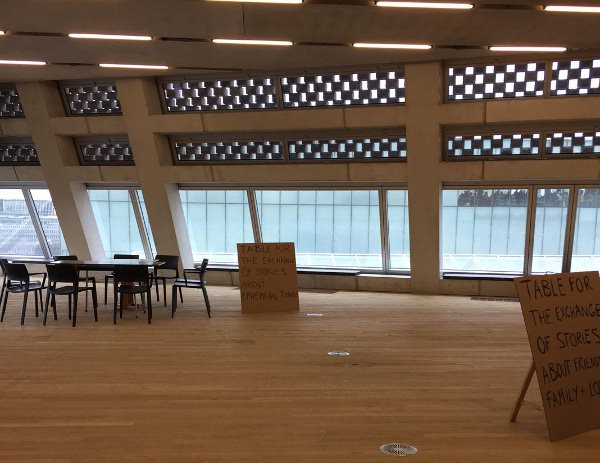
Tate Exchange, Tate Modern, London UK. B. Bunt
Rather than presenting fieldwork as such, the Tate Exchange renders the methodological essence of fieldwork. It renders the studio and gallery as a social field.
But let’s step back and consider a more iconic fieldwork scene. Jeff Wall’s ‘Fieldwork’ (2003) depicts archaeological fieldwork in British Columbia.
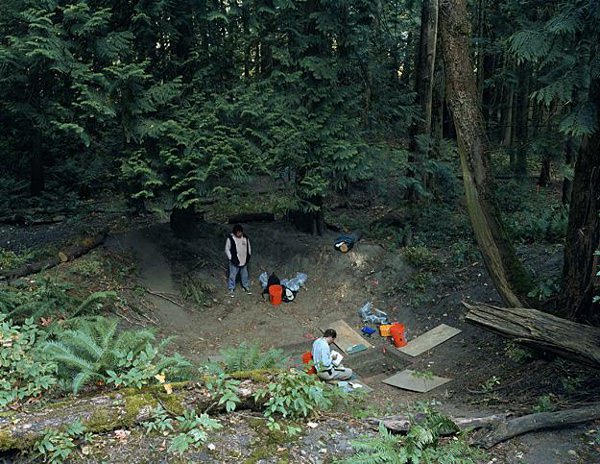
Jeff Wall, Fieldwork. Excavation of the floor of a dwelling in a former Sto:lo nation village, Greenwood Island, Hope, B. C., August, 2003. Anthony Graesch, Dept. of Anthropology, University of California
Two fieldworkers excavate the remains of a Native American floor, now a metaphorical field within a literal forest. The floor has passed outside and merged with the ground. It is little more than a hole. An archaeologist kneels before it taking notes. He is out in the field but immersed in his fieldwork. He fashions his own delineated space within the field – a space of private observation and writing. He attends to a discrete, excavated area within the larger field and fashions his own field of observation and description.
A second fieldworker stands at the margins beneath a lofted branch - his feet shoulder width apart, his hands in his pockets. He is immersed differently in the field, less through concentrated absorption than distance and inaction.
The fieldworker itself becomes the subject of fieldwork. Jeff Wall photographs the fieldworkers. He portrays the research process in carefully composed formal-aesthetic terms. It is as though a painting of a Renaissance forest scene has been updated – no longer full of cavorting centaurs and nymphs, there are instead two archaeological fieldworkers; who despite themselves, despite their level of distraction or methodical calm, somehow still manage to summon up the memory of an earlier mythical field (accentuated by the subdued, meditative, untimely light). How is this all enabled? It is perhaps at least partly by fashioning a relation between interior and exterior space – elaborating curious openings, borders, thresholds and rooms within forests and fields. All of this suggests the complexity of fields and fieldwork. Fieldwork involves much more than simply stepping outside.
Contemporary art often renders the relation to the wider social and material field in terms of a tension between the aesthetic and the non-aesthetic.
[T]he experimental artist who plays with the commonplace does so in the very midst of crossing the street or tying a shoelace. There is no excerpting and reenacting them on a stage, no documenting them for a show. Art is thus easily forgotten. And that is the condition for experimentation: the art is the forgetting of art. (Kaprow 2003: 249)
Art exists as a separate world since anything whatsoever can belong to it. […] Art is given to to us through these transformations of the sensible fabric, at the cost of constantly merging its own reasons with those belonging to other spheres of experience. (Ranciere 2013: X-XI)
We know this story well. To enter the field of contemporary art is to enter a realm of paradox. Art constantly risks passing beyond or outside art. It becomes characteristically manifest at the instant that it risks its own disappearance. This double manoeuvre of rejection and return takes shape as a conventional strategy and expectation.
And it is this sense that there is perhaps no genuine passage out into a wider field, because the wider field (its aesthetic alienation and uncertainty) is a feature of art itself. The larger field is actually a subset of the smaller field. Art stages its relation to multiple outsides. For all of its apparent exteriority, all these other places appear in picturesque terms. Here a sly relation between the conventional aesthetic attitudes of the picturesque and the sublime is evident. The infinite prospect of the sphere of non-aesthetic sociality (everyday life, other practices, other disciplines) develops its own conventional iconography and tropes (ellipses, ephemeral records, rough diagrams) – a set of aesthetic lenses for negotiating and representing all manner of alien fields.
So we must cautious about fieldwork. We must be suspicious about envisaging a simple relation to a pure exterior.
However there is also scope to read Rancière’s statement in a less binary fashion. While at one level it reflects upon the conventional dialectic between inside and outside in contemporary art, it also suggests something more – something that may help progress matters beyond the impasse of a formal paradox. With its capacity to accept anything and to expand its boundaries however it likes, art has the potential to re-position fields and entities – not so much simply to make them strange within art, but for themselves and in relation to one another. Art – a very imperfect container – has the capacity to juggle elements, and this juggling has implications beyond art itself (partly because art lacks the power to contain everything that it engages with). In this sense, key forms of contemporary art work less to colonise aspects of ordinary experience than to tease out dimensions of estrangement and possibility.
But I would like to speak more personally than generally. I am trying to account for my own ambivalent relationship to fields and fieldwork.
My father was a marine microbiologist who wrote extensively of his fieldwork experiences in the Antarctic and in Northern Queensland. His various memoirs describe a departure from the conditions of ordinary scientific life – desk and lab. The field appears as a heightened and memorable space. It takes shape in compelling narrative terms. It is conducive to moments of drama, humour and poetic observation.
While my father pursued his scientific career, my mother managed domestic affairs and pursued a private vocation as an artist. In the early 1970s she bought herself an old Viscount caravan and installed a large viewing window on one side. This allowed her to travel around Townsville – down to the river and out to the Town Common – to paint the local landscape. Instead of painting in conventional plein-air style she painted the view from inside the caravan. This allowed her to stay out of the hot sun and to make herself a cup of tea whenever she liked.
Her fieldwork did not represent a grand escape into the outdoors. Nor did it adapt an adventurous narrative form. It was simply a means of enabling her to work effectively as an artist. Her focus was on observation and gentle formal abstraction. She made no effort to glorify her process. There was no fetishisation of standing on the ground or of seeing things directly. It was very important for her that she actually went out into the field, but she did not mind that she was looking out through glass from a shaded space. In a sense then, rather than leave the studio behind, she took it with her. It occurs to me that many artists do this, even when they feel they are doing precisely the opposite – when they feel they are encountering the world beyond any form of studio constraint. The studio has a way of following you into the field despite our best intentions.
In any case, what interests me about my mother’s practice was that it was unconcerned with any sense of opposition between studio and field. It represented a novel, practical alignment of the two and a deconstruction of their terms of necessary difference.
This may have left me confused about what fieldwork represents. At one level I am drawn to my father’s conventional romanticism, at another level I can’t resist regarding it ironically. My mother’s practice appears pragmatic and deflating, but possibly also reveals another layer of romanticism (and realism) – one that avoids standard artistic myths so that, in very contemporary fashion, art and the wider world can intersect.
Finally, passing from memory to fantasy, I can remember envisaging the indeterminable contours of an event. I began by conceiving a sporting event – a fun run or something, but imagined that it was much longer than usual, so that it took hours, days, weeks and years to complete. A route so long that it could not even be properly mapped. And then I imagined that the event extended beyond the running itself to involve all manner of other aspects of life – eating, sleeping, going on holiday, failing to do exercise, missing out on a job, travelling overseas, experiencing the wreck of a major relationship, etc. The event consumed every aspect of life, but provided nothing in return. All you could do was commit to the event without any expectation of progress or recognition.
What relevance can this nightmarish event have for making sense of fields and fieldwork? None necessarily, but for me it suggests that a field, like an event, need not take neatly determinable shape and that fieldwork, like participation, need not adhere to a coherent methodological pattern. The field shifts shape as we move within it and our fieldwork shifts shape within this shifting field. This adherence to multiple layers of instability is what a rigorous practice of creative fieldwork demands.
Greetings from the Cane Fields
Lucas Ihlein
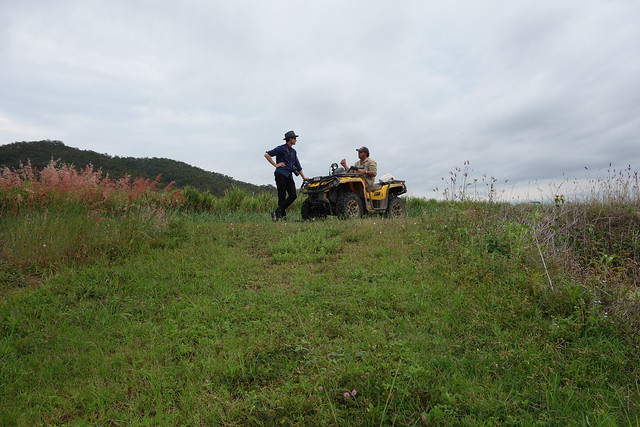
Lucas Ihlein with Mackay sugar cane farmer Joe Muscat talking about "sediment traps" on Joe's farm, September 2016. Photo by Laura Fisher.
I’m writing my bit of this editorial from a makeshift office underneath an old Queenslander, in the heart of sugar cane country in Mackay. Together with my family and my artistic collaborator Kim Williams, I’m stationed here for a couple of months to begin working on a new project called Sugar vs the Reef?. This is a sprawling exploration of a complex social, economic and environmental tangle. We are prising open the relationship between industrial agriculture and the "natural" heritage of the Great Barrier Reef.
While we’re here, Kim and I are hanging out with farmers, millers, and industry representatives from the sugar cane industry, as well as reef scientists and employees of the Great Barrier Reef Marine Park Authority.1 Each day, Kim and I visit farms, sit in organisational offices, drink giant mugs of tea. We’re meeting with local members of parliament, council politicians, and curators at the regional gallery. We’re tracking down multicultural labour histories of sugar plantations, and we’re looking for stories from traditional custodians of the Pioneer Valley.
We’re talking about soil, superphosphates, and sediments in the Pioneer River, as well as debt, family structures, and international price mechanisms for sugar as a tradable commodity. We’ve formed friendships and working dialogues with a whole range of people, and yet I think its safe to say that none of them fully understand what it is we’re trying to do. We’re not branded environmental activists; we’re not politicians; we’re not scientists. We may be academics but we don’t really do research in the “normal” way. And we’re not even particularly recognisable as artists!
So what are we doing? We’re working it out as we go along. We’re “interested non-specialists”, muddling through – trusting that “something” will emerge through the process. Such is the nature of “fieldwork” in the field currently known as “Socially Engaged Art” (SEA).
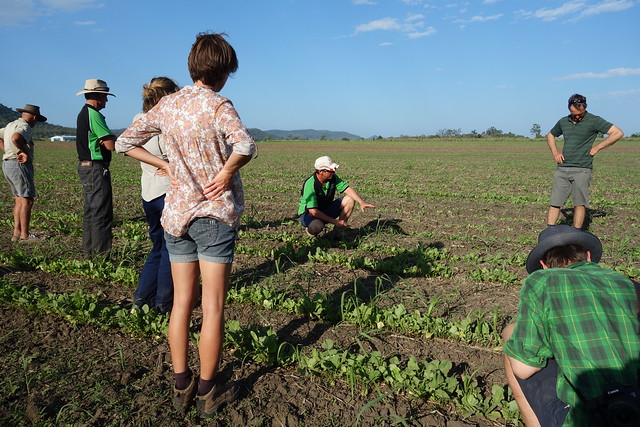
Sugar cane farmer Simon Mattsson explaining his method of multi-species intercropping at a field day run by Central Queensland Soil Health Systems, September 2015. Photo by Laura Fisher.
One of the more useful observations about this way of working was made a few years ago by New York artist and educator Pablo Helguera. Rather than seeing the process of “muddling through” as a sign of a poorly defined and ill-disciplined methodology, Helguera emphasises that the ambiguous role of socially engaged artists is precisely where we might make our strongest contribution to complex matters of social significance.2 In his book Education for Socially Engaged Art Practice: A Materials and Techniques Handbook, Helguera writes:
Socially engaged art functions by attaching itself to subjects and problems that normally belong to other disciplines, moving them temporarily into a space of ambiguity. It is this temporary snatching away of subjects into the realm of art-making that brings new insights to a particular problem or condition and in turn makes it visible to other disciplines. (Helguera 5)
There’s an increasing number of artists working in this way across the world, and as we develop the nuances of our approach, some of us try to share our discoveries with each other, so that we might exchange tactics and learn from mistakes. This “Field Work” themed special edition of Unlikely journal is one place where such an exchange is playing out. As you’ll see, each contributor faces a fundamental challenge of socially engaged art: how to communicate about what happened “out there in the field” so that people who weren’t there can get a sense of what it was like.
This problem – the transmission of experience beyond the experience itself – is not new to SEA: we have the whole history of performance art as one of our cultural antecedents. However, many of us now want to go beyond the traditional technologies of performance documentation, (still photographs and statements of artistic intention) which left behind many questions:
What was it really like to be there in the audience? How did the artists’ actions and interventions articulate with the cultural mood of the time? What were the aesthetic characteristics of then-available technologies of media production? As technology continued to evolve, how did the artwork transform itself? What effects did the work have on the world in which it was situated? What kind of new social relations did it bring about?
With the dissolution of the standard audience-performer relationship as a commonplace aspect of dialogical SEA, these questions become even thornier. Each time Kim and I meet and talk with people working in the cultural/agricultural field in Mackay, there is no “audience” per se – except perhaps temporarily – and even then, at least half the time it is we who are the audience. There are fascinating and troubling things going on through our processes, and we need to be able to open these up to others who aren’t here with us right now. How can we do this?
Some of the contributors to this edition of Unlikely create “communication artefacts” which function as new artworks in themselves. These artefacts – like David Brazier and Kelda Free’s postcards from a covert camping holiday in an island pond in central London – embody something of the “original” experience, at the same time as communicating across the experiential divide. The communication artefacts made by Meghan Moe Beitiks bend the convention of the scientific lab report, and are created specifically for a web browser experience. Beitiks’ artwork-as-document seems to embrace the fact of lossy transmission. Her partial, scrappy aesthetics of notetaking are an essential poetic consequence of her science-art collaborations.
While Brazier and Free tell micro-stories on their postcards, others – like Vanessa Berry, Dominic Redfern, and Nancy Mauro Flude – deploy non-fiction narrative from their fieldwork adventures in a much longer form. These three contributions weave personal stories with philosophical analysis. Readers are carried along on a journey beyond the writers’ desks to places like the unexpected wilderness of Sydney suburbs, or the weeds of regional Victoria, or the explosive collaborations of Haiti’s Ghetto Biennale. Writing in this way, each artist reflects on their own work as a means of transforming the originary experience itself. In the process of critical reflection carried out as a communicative public action, the fieldwork experience becomes something new.
Unlikely’s open online format creates opportunities for the emergence of hybrids forms of academic writing. Collaborators Catherine Clover, Johanna Hallsten, and Shauna Laurel Jones use the journal to engage in dialogue with each other from three distant geographical locations (Melbourne, London, and Reykjavík) as they recall a very lively residency in an old church in east London. Field recordings of urban birds and the bell-ringing ceremonies of the church’s custodians alternate with photographs, textual tales, and thought excursions which extend the project well beyond the period of its original experience in Bethnal Green.
Besides stories and audio recordings, the map is a communicative tool that wields great power across time and space. Alinta Krauth’s contribution to Unlikely introduces and contextualises her artwork entitled “Walking Unexpectedly”. Importantly, the contextualising communique sits alongside the work itself, allowing the reader to bounce back and forth between browser tabs, experiencing stacked layers simultaneously: description, reflection, analysis, “primary document”, graphic design, animation, typography, and sound.
Similarly, Campbell Drake and Jock Gilbert report on a collaborative experimental workshop for artists and architects in rural NSW which took mapping as its primary focus. In the examples discussed by Drake and Gilbert, mapping is not simply a method of communicating an existing reality “out there”, but is a tool for actively transforming that reality.3 Their contribution not only describes discoveries and successful attempts at using mapping to understand the mediation of culture by geography, geology and topography, but also describes the failed iterations which led to the dawning of new knowledge.
The materials of communication (flyers, signs, brochures etc) produced before, during and after a work of site-specific live art can leave behind a wealth of accidental residue enabling access to those who weren’t there at the time. Sean Lowry explores the important role played by these archival materials, which he calls “paratexts”. Lowry argues that paratextual artefacts are often overlooked as merely “functional” and are therefore not considered an integral part of shaping a live art experience. His contribution to Unlikely seeks to correct this oversight, re-importing the paratext into an expanded version of what he calls “the world of the work”.
Some of the major frameworks used for developing complex socially engaged art projects – the residency, the grassroots art space, the international arts festival, as well as the internal logic of artistic practice itself – are given deep attention in this edition of Unlikely.
Writing collaboratively, Marnie Badham, Kate Hill, Ted Purves, Susanne Cockrell, and Amy Spiers examine Purves’ notion (via social theorist George Simmel) of the “social form”. They offer the artist-in-residence model as a key social form occupied by artists working in this field, and present their own experiences at a place called Laughing Waters as a case study. Adva Weinstein’s contribution also provides an in-depth analysis of her experience at a residential dance workshop in Thessaloniki, Greece, staging the foundational theories and practices of exploratory dance alongside diaristic notes from the unfolding of this 14 day intensive “laboratory”.
Maria Miranda’s contribution to Unlikely forms part of her long-term investigation into the social function of artist run initiatives (ARI) in Australia. Miranda reflects on her own process as she begins to invent a unique method of embodied artistic research which she calls “following”. Following is designed to step into rhythm with the diverse (and largely unglamorous) everyday routines of her subjects. The people she follows do not sit still and wait patiently for the researcher – and so Miranda’s contribution attempts to sketch out the parameters of wider field of artist-run practices beyond the doors of small gallery spaces.
Similarly, Laura Fisher’s goal – to develop an ethnographic approach to being with socially-engaged artworks – is an acknowledgement that new methods of research are required to get to the heart of the aesthetic experiences generated by this sort of work. She visits the Echigo Tsumari Art Triennale in Japan with an audio recorder, talking with artists as well as some of the local people within whose traditional rice farming village a range of site-specific contemporary artworks manifest themselves. Fisher generously includes her own fumbling attempts at bridging the gaps between herself (as an art historian-cum ethnographer), the artists, and the farming communities. This process is essential in laying bare the relationships between artworks and situated communities.
Considering a range of different “fields” which cut across her own practice as it has developed over several years, Becky Nevin Berger’s contribution is equally generous in opening itself for scrutiny. Sprawling landscapes viewed from space; the private sphere of her domestic environment; and the public context of the exhibition venue are all fields through which her artistic practice travels (not always seamlessly) and Nevin Berger’s contribution to Unlikely is an attempt to assemble a fuller picture of these multiple fields.
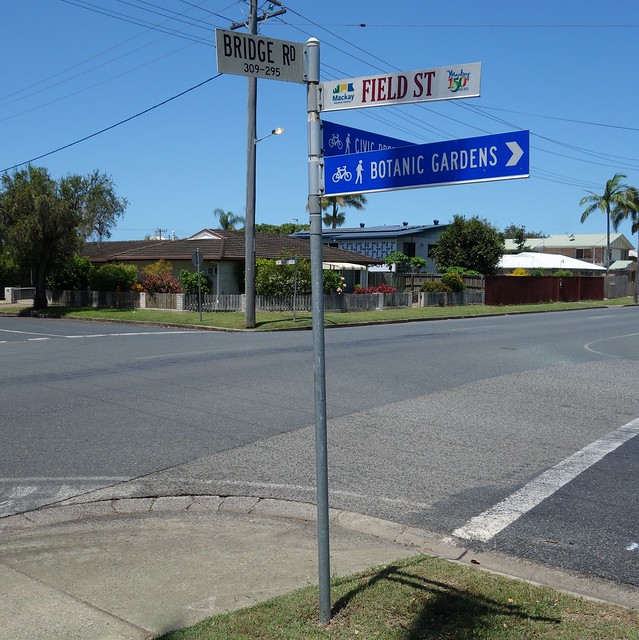
Corner of Field Street and Bridge Road, West Mackay, October 2016. Photo by Lucas Ihlein.
In touching on the variety of contributions to this edition of the journal, I’ve described many of them as “attempts”. This is not accidental. Framing a space where creative practice can present itself on its own terms, it’s important for a journal like Unlikely to attempt to go beyond the standard format of the academic paper or essay. As a “social form” the academic paper seems to accept its role as a reflection on practice rather than as reflection in practice.4 Contributions to Unlikely are thus encouraged to go beyond the standard essay paradigm. We want them to worry away at the traditional heirarchies between experience and explanation which still haunt creative practice.
Bruno Latour tackles the problem of fieldwork and its aftermath in a wonderful academic paper (!) called “Visualisation and Cognition: Thinking with Eyes and Hands” (1986). Latour invents the term “immutable mobiles” to describe technologies of communication and exchange which allow embodied situated experiences in the field to be made abstract, so that they can circulate freely, wielding greater social influence (and even domination). It is not “the experience itself” in the field, but rather the maps, diagrams, tables, reproducible images, and inscriptions of all kinds generated in the wake of that experience which become immutable mobiles with the power to make things happen in the world:
If you wish to go out of your way and come back heavily equipped so as to force others to go out of their ways, the main problem to solve is that of mobilization. You have to go and to come back with the “things” if your moves are not to be wasted. But the“things” have to be able to withstand the return trip without withering away. Further requirements: the “things” you gathered and displaced have to be presentable all at once to those you want to convince and who did not go there. In sum, you have to invent objects which have the properties of being mobile but also immutable, presentable, readable and combinable with one another. (Latour 6-7)
The challenge for practice-based research in the academic setting is that no matter how experientially rich the processes of an artwork might be, it is still regarded as “mute” until transmuted into some form of immutable mobile. We are still some way from the maturation of this endeavour: even this editorial resorts to using consecutive paragraphs of didactic text to make its point!
Furthermore, we need to continue working as a community of artist-scholars to develop adequate methods for peer review of hybrid forms which combine artwork and critical reflection. If the generation of new knowledge is a criteria for acceptance, what forms of knowledge do we acknowledge? And how do we account for forms which fall outside of existing modes of the “acknowledgeable”?5
My own utopian dream is of a journal whose contributions could bridge the worlds of university research and the wider “field” beyond our discipline. Such a journal could be accessible (even if not always comfortably so) by the farmers and reef scientists we’re working alongside here in Mackay, by scholars from the environmental humanities and from cultural geography, as well as by those within our own heartland of creative practice. While we strive to mature the discursive tools in our own field, we must also be conscious of the need to communicate with those who work “out there”.
References
Helguera, Pablo. Education for Socially Engaged Art Practice: A Materials and Techniques Handbook. New York: Jorge Pinto Books, 2011. Print.
Kaprow, Allan. Essays on the Blurring of Art and Life. Berkeley: University of California Press 2003. Print.
Latour, Bruno. “Visualisation and Cognition: Thinking with Eyes and Hands”. Knowledge and Society: Studies in the Sociology of Culture Past and Present. Vol. 6 (1986): 1-40. Print.
Lindblom, Charles E. “The Science of ‘Muddling Through’”. Public Administration Review 19.2 (Spring 1959): 79-88. Print.
Rancière, J. Aisthesis: Scenes from the Aesthetic Regime of Art. London: Verso 2013. Print.
Schön, Donald. The Reflective Practitioner: How professionals think in action. London: Temple Smith, 1983. Print.
Wood, Denis. Rethinking the Power of Maps. New York: Guilford Press, 2010. Print.
Footnotes
- The project is produced with fellow artists Kim Williams and Ian Milliss: http://sugar-vs-the-reef.net↩
- For more on “muddling through” as a legitimate means of enquiry, see Lindblom 1959.↩
- One of the most exciting books I’ve come across about the transformative potential of mapping is Rethinking the Power of Maps (Wood 2010).↩
- For a comprehensive discussion on the differences between “reflection in” and “reflection on” practice, see Schön 1983.↩
- I am grateful to my colleague Diego Bonetto (an academic outsider and renowned expert on edible weeds) for introducing me to the term “acknowledgeable”. “Acknowledgeable” recognises the potential for an existing item of experience to be admitted as a socially acceptable idea. For example, in response to the presentation of an unproven or experimental way of framing a problem, Bonetto might tilt his head, look into the distance and say, “Hmm, that’s acknowledgeable”. An acknowledgeable thing is on the cusp of broader social acceptance. It will require the consent of a participating community prior to being actually acknowledged.↩

